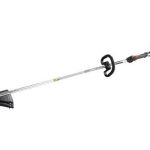A chainsaw can be one of the most important tools for a family that needs to maintain a property. For example, you will be required to trim branches off of trees and trim shrubs at least once a year. The chainsaw is also an ideal tool for those families that have a home with a fireplace or a second home in a wooded area that may also feature a fireplace. A chainsaw is an essential tool for cutting and retrieving wood for a fire in said fireplace.
There are many component parts to a chainsaw. They include:
• The chain
• Guide bar
• Oil cap
• Front Handle
• Trigger
• Fuel Cap
• Safety switch
• Hand guard
• Brake
• Muffler
Gasoline is the fuel that feeds a chainsaw motor. Gasoline that you would purchase from a gasoline station may include ethanol. Ethanol is a biofuel that is added to the gasoline.
Ethanol can cause problems with motors used to power chainsaws. In just a few weeks, the substance can absorb moisture from the atmosphere. The combination of water and ethanol separates and sinks and the water can cause corrosion in the metal of the engine and gums up the carburetor. It is suggested that you use all-petroleum-based gasoline when fueling your chainsaw.
Be sure that you know of stations in your area that sell non-ethanol premium gas.
If you have to use gasoline that includes ethanol, add a stabilizing additive to the gas tank.
Chainsaw Maintenance
You will also need a good quality bar and chain oil and 2-cycle oil. Quality bar oil is more viscous than a bargain brand of oil and will help your chainsaw to last longer.
Many people who use chainsaws advise that you fill the gas and bar oil reservoirs whenever you use the saw, even if it is just for a few minutes. This way you are sure that the saw will not run out of lubricating oil while you use it. If the oil runs out while you are using the saw, more friction is created and the heat from the friction can cause serious damage to the saw.
It is advised that you perform basic maintenance on the chainsaw each time it is used. The chainsaw comes with an owner’s manual. So whenever you are in doubt about any aspect of maintaining the machine, refer to the manual.
Generally, however, daily maintenance tasks include inspecting the bar for wear, removing and cleaning the air filter. Make certain that you close the choke so debris doesn’t go into the carburetor. Other tasks include checking the muffler and spark arrester, which is the little screen over the muffler, performing a black/gray check (all of the safety features of the chainsaw on either black or gray), and a visual sweep of the saw to make certain that everything is tight.
In addition, it is advised that you clean the saw bar’s chain groove and flip over the bar after a day of use. This assures that everything will wear evenly. Once cleaned, place the chain back on the saw and tighten it. A properly tensioned saw will have no visible slack in the chain and should give about an eighth of an inch when stretched between your thumb and forefinger and then snap back when you release it.
How To Sharpen A Chainsaw
The saw chain features cutters and rakers. The cutters cut and so they have to be sharpened often to be effective. The raker controls the depth of the cut and must be filed down as the cutters wear over time.
There are two file guides. One rests on top of the cutters so that the round file you use to sharpen is positioned on the cutter properly. Hold the file guide slightly downward and at the proper angle marked on the file guide and on the cutter. File from the inside of each cutter to the outside, and file in one direction, away from you. Stroke each cutter about 5-10 times and then check for sharpness.
The second file guide is the roller guide. It sits on the links of the chain and holds the file in the proper position and angle. The round file is passed over the plastic roller and sharpens the cutter. Sharpen all the cutters on one side of the chain, spinning the chain as you go. Once done, sharpen the cutters on the other side of the chain. This task should take 10 to 15 minutes. Check the manual for the proper size of file you need to use and the filing angles.
The rakers height should be slightly less than that of the cutters. Making sure this is executed properly is critical. If the rakers height is too little in relation to the cutters, the cutters will just ride over the wood and not cut it. If the height of the rakers is too high, then the saw will jump and be erratic. After sharpening the cutters three times, check their depth with a depth gauge and file and round off as needed.
(Source: Art Of Manliness.com)









